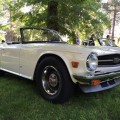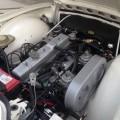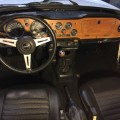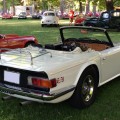This TR6 caught my eye because of the fuel injection system that has been installed. See, in Europe the TR6 actually came with fuel injection from the factory. As a result, it benefited from a lot more power than the carbureted version we received here. We are talking about an almost 50 horsepower difference! I’m sure they were a handful to drive and those cars could be what people were referring too when they coined the “hairy chested sports car” phrase. I’d like to think that the Patton Machine fuel injection found on this car could create similar thrills? Find it here on KSL out of Bluffdale, Utah for $8,900. Thanks goes to Mac H. for the submission!
Jul 23, 2015 • For Sale • 16 Comments
Fuel Injected 1976 Triumph TR6
Disclosure: This site may receive compensation from some link clicks and purchases.











I remember these were plenty powerful in stock form. If you put 50 more horsepower to the rear wheels you’d better know how to drive them! ^_^
The pics look like carburetors on the engine? Is it maybe throttle body injection? Also seems like a lot of rust for a Utah car as they don’t put salt on their roads out there…
This looks too good to be true, to put it mildly! I would expect a bone-stock, emissions-strangled TR6 in this apparent condition to go for more….
I had never heard of the “Patton Machine” F.I. system. Google is your friend, though, and it looks to be a simple, successful system. Better, probably, than three Weber side-drafts, though for appearance reasons alone I’d prefer the latter.
Overall, looks like a wonderful car. Wouldn’t surprise me if it has already sold.
Dr Jeckyll and Mr Hyde? This car may have surprises the buyer will not be happy with.
Looks like throttle body (‘carb body’?) FI. Have never seen that. I was expecting the Euro version FI that was on the TR5. I’m not sure how the Patton Machine system works. Would it gather as much information for metering fuel as ‘real’ FI? Anyone know?
those are bone stock engine choking Stromberg carbs. Somebody doesn’t know what he’s got…
interesting car but i too would need to know a lot more about the FI. this aftermarket system may be scaring people away.
Patton system has an excellent reputation in Triumph circles. GM stuff, I believe, and well vetted. Nice price!
that is good to know. maybe Jesse should try the system on the BF mgb and see what happens.
Actually the asking price – meaning they will take less – is 8400 which seems like a bargain especially if the little to no rust is true.
Good heavens, you’ve got to be kidding. I never had any issue with the Zenith-Stromberg carbs that came with this car. Fact is, I preferred them over the SU’s that were on my MGB. I like TR-6’s ( and most older British cars) for their simplicity and not this spaghetti bowl of hoses. The TR-6 was never intended, I feel, to be a rocket, and had plenty of power. I agree with jim s., this would scare me away.
Alfa Romeo had run fuel injection on the U.S. bound 105/115 cars since 1969. Many owners ended up switching to twin Weber side drafts. Interesting how f.i. is not considered big news in the Alfa circles…
Thanks Jesse for posting my car. Its very fun to see it in the spotlight!
It looks like a great discussion going on above. Comparing this system to a more mechanical antiquated Alfa injection is like comparing drum to disk brakes. They both get the job done, but if you don’t know how to properly adjust drum brakes they’re not going to perform very well. Disk brakes are much simpler and perform much better. Alfa fuel injection was great if the person tuning the car knew what they were doing or you didn’t have to replace the very expensive components. Most owners and shops didn’t know what they were doing so the system received a bad wrap and owners removed them. Today people are not taking the fuel injection system out of their cars and going back to carburetors. These GM parts have been worked through. While computers in vehicles today have introduced other frustration for their owners this system is very basic with few parts to have issues with.
I grew up mainly around British cars. As an adult I’ve been interested in learning more about all brands. Besides this TR6 I currently have a 68 Mustang, 59 Chevy Apache, 57 356A and my new 58 TR3. This is my 5th British car. I have not done this TBI system for improved horse power, better fuel mileage or because Zenith-Stromberg carbs are too difficult to tune. I decided with this car I would try something different, but at the same time not jeopardize the value of the vehicle. I’ve had so many people come to see how the system works. Even the purists who initially claim blasphemy grin when they see the car start instantly and come alive. Once they learn everything can be unbolted and reversed a seal of approval is given.
Rick Patton at Patton Machine knows what he’s doing. He is great to work with communicating quickly, professionally and honestly. I will be contemplating putting another system in my new TR3, which is in need of a full restoration.
A quick note about the TBI components. There are but 3 components that are bolt on fitted to the engine. All other items are not permanently attached to anything.
1. Aluminum injector adapters located under the dashpot covers which are installed using the stock dashpot cover holes.
2. TPS: Throttle position sensor. This sensor is bolted onto the side of one carb and simply put tells the computer where the gas pedal is located in its travel.
3. Distributor “guts”. A stock distributor can be used. I chose to remove the internal components of the original distributor and put in place a system that can be monitored via the main computer.
The only real “permanent” item would be an O2 sensor bung which has been welded onto a section of exhaust pipe.
Again, all of the above items can be removed and the original components installed. The original wiring harness is unscathed. The throttle body injection system is completely separate.
In an article Jesse wrote a while back he wrote “Cars are more than transportation to me. Every one is an experience and I want to have as many as I can before I die.” That has rung so true to me. I’ve thoroughly enjoyed the time with my TR6 and am excited for the journeys to be had with my new TR3. This is a great price for the vehicle. I’m not a flipper or wanting to make money off off this. The injection kit was north of $1800 alone. Hopefully this TR6 will go to a good home where it will be kept on the road and driven often.
Thank you all for looking at my ad!
Sincerely,
Mitch
Mitch, I wasn’t comparing SPICA injection to the injection on your car. It was just interesting to see all the excitement over a fuel injected ’76 TR. You are correct about properly tuned SPICA and that many folks didn’t understand how to tune them with exception of Wes Ingram and few others. I will disagree about comparison of the SPICA to a drum brake though – it’s one of the better engineered fuel injection systems around. Having owned a number of Alfas, specifically 3 ’69 cars – 2 Berlinas and a 1750 Spider – I can attest to that with certainty. Best of all it was factory installed so even purists were happy :))
Tirefriar, thanks for the response and explanation. I’d like to examine and study the SPICA system more.
Mitch, this would be a good place to start as any:
http://www.wesingram.com/
Been hoping to see one of these FI systems installed. Nice to see the same look under the hood, yet injection control. Not that the Strombergs were bad… they always worked fine for me.
Well engineered. interesting.